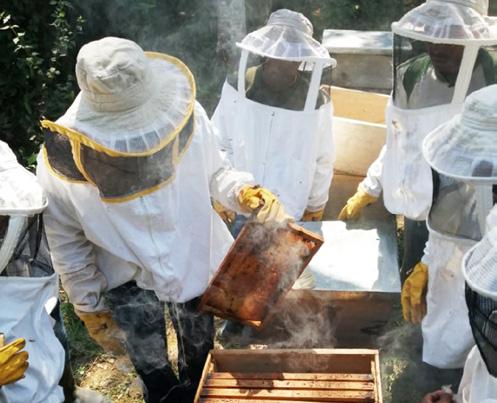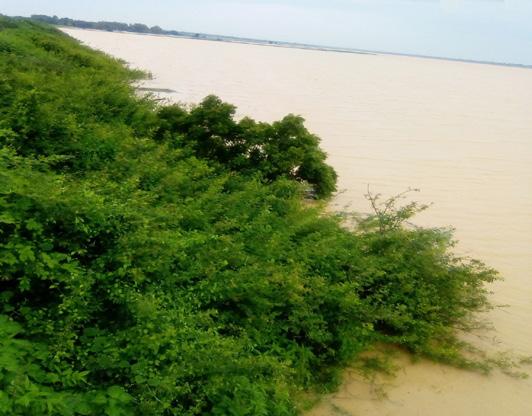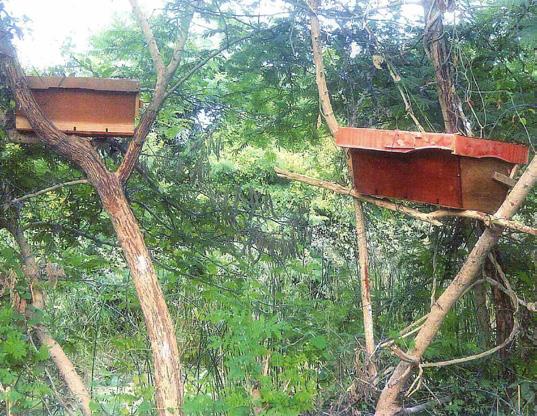
7 minute read
Community beekeeping in northern Guatemala
Barbara Vallarino, Executive Director and Elmer Urizar, Field Technician, EcoLogic Development Fund, Quetzaltenango, Guatemala
We are grateful for the generosity of the FAO 1% for Development Fund*. This support provided in July 2019 has allowed us with our partners in Ixcan, to make significant progress towards our project goals. Our field staff purchased the first 50 hives from a local supplier to ensure a strong start to the project and with healthy colonies. They developed a comprehensive technical sheet specifying the requirements for the hives. After receiving three proposals and selecting the best one, our field staff visited the facility to ensure the hives were built to specification. Selected sites were visited to ensure appropriate conditions. Once approved, 50 hives, gloves, smokers and suits were delivered to 25 new beekeepers in the two new communities. The communities are remote. The bees were delivered at night so that they would be calmer. The day after each delivery, a technical assistant visited the new beekeepers to ensure that everything was in order. Ixcan TV covered the event. All the beekeepers signed an agreement acknowledging receipt of the equipment, expressing their commitment to care for the bees as they had been taught through the workshops, and committing to developing two additional colonies which they would pass on to new beekeepers by May 2020. Field Technician, Elmer Urizar has been providing remote guidance to the beekeepers and wrote the following update in May: The beekeepers and farmers I work with have requested technical assistance which I have provided over my cell
Barbara Vallarino with Nuevo San Lorenzo Community phone and with text messages. Just as the world has adapted to all things virtual I have been able to continue walking these communities through key processes of honey production and harvest, remotely. Although the communities’ technology is not very advanced, many have cell phones. A phone call and text messages can do the trick just as well! In March, I had several phone calls with beekeepers. We discussed how to create and place wax foundation for the bees to build honeycomb to help them work. In April, I had a lot of communication with the producers because everyone was ready for the honey harvest. The harvest has been good. For example, Don Jorge, with his son Moisés, from the community of Nuevo San Lorenzo each harvested 18 litres of honey. Marcos, Benino, and Vicente, from the Machaquila II community, stated the same. It is worth mentioning that these are the new beekeepers who started in 2019.
* https://www.onepercentfund.net

Apiculture in Kano State, Nigeria
Dauda Sani Abbas, Audu Bako College of Agriculture, Dambatta, Nigeria
Demand for honey continues to increase in Kano State and across Nigeria. What role can our government play in boosting beekeeping production? What lessons can be learnt from dynamic international honey sellers that may guide our emerging State beekeeping?
Introduction
Kano State is in northern Nigeria, in the semi-arid zone of the country with drought and unfavourable weather conditions. The State has a population of 15 million: the most populated in the country. Agriculture is the main occupation with cereals and groundnut grown as food and cash crops. Beekeeping and honey hunting are other aspects of cash-flow among farmers. There are 50 beekeeping groups and societies, with 2,500 members in the State.
Improving the forest
From 1990 to 2000, Kano State Government focused its attention on the control and management of the forest cover, establishing: • 27 irrigated forestry nurseries • 40 rural wood lot plantations (each 35ha) • 60 watershed plantations of 120ha • A sand dune stabilisation project over 65km in affected areas • 395km of roadside tree planting.
Bee forage in Kano State
In addition to the natural forest, Kano State Government has established many small-scale forest plantations, watershed plantations and roadside tree planting programmes with the aim of supplementing the fuel requirements of rural people and to protect large bodies of water from silting or collapsing, and to protect roads. (Danyaro 1991). Yanbawa shelter belt (the largest plantation in Africa) located in the Dambatta local government area of the State, contributes to the development of beekeeping by providing adequate forage for bees and pollination of other nearby crops.

Trees in the forest and plantation
Most of the plantation trees are Eucalyptus sp and Neem Azadirachta indica. Others include Egyptian mimosa Acacia nitotica and Gum Arabic Acacia senegal.
The natural forest consists of hundreds of flavour-giving traditional plants, shrubs and trees including: • Locust tree Parkia biglobosa which gives one of the sweetest honeys • Shea butter Vitellaria paradoxa also provides a flavoursome honey • Ginger bread - plum tree Parinari macrophylla provides a very thick honey • Guiera senegalensis provides the lightest (whiteamber) honey • Christ’s thorn Ziziphus spina-christi we obtained a very strong honeycomb from this tree • Black plum Vitex doniana produces a dark (black) honey.
The role of government in boosting honey production
Beekeepers and honey hunters have benefitted from abundant supplies from natural and planted forests and water dams. Kano State government recognised the importance of honey and beekeeping. The State government provides training and empowers participants:

• Harvesting equipment is provided • One straw hive and one top-bar hive are provided • Each participant is given NGN10,000 (US$26; €22) to encourage business expansion.
Beekeeping training in Kano State
Kano State beekeeping training programmes began in 2010 under the Kano Afforestation Programme (KNAP). According to Training Officer Mutari Bello, the programme was targeted: • To increase investment in beekeeping industries • To add value to beekeeping products • To boost local and regional honey markets in the
State and country • To encourage farmers to keep bees • To utilise beekeeping to enhance the image of Kano
State. Alhaji Aminu Kabiru, KNAP Project Coordinator reported to News of Nigeria that the State plans to train 300 young people in 2020.
Honey flow during Covid-19 restrictions
In many developing nations the demand for honey continues to grow. With rapid population growth, rising income and expanding urbanisation this trend is expected to continue. Revenue generated from honey sales has supported the livelihoods of Kano State beekeepers during this period. I am a good example: I generated over NGN400,000 (US$1,050; €900) and was able to purchase a van to help in my beekeeping. During the Covid-19 shutdown I travelled to honey markets in Dambatta, Darki, Doguwa, Gwarzo and Kura (within the State) to buy honey because my apiaries alone could not satisfy my customers. I met beekeepers in good spirits generating a substantial return from their bees. Many told me that this was due to the absence of imported honey from neighbouring states. We realised that people came from all over Nigeria to purchase honey in Kano State immediately after the shut-down - another indication that we have abundant honey!

Top-bar hives for distribution to KNAP training participants
References
BELLO,M. (2010) Keynote Address delivered during the Opening Ceremony of beekeeping training in Kano State. Unpublished manuscripts. DAM SAFETY MEASURES REPORT (2004) Volume 2 E863 Federal Republic of Nigeria. Federal Ministry of Water Resources, National Urban Water Sector Foam Project (NUWBRP). DANYARO,M.M. (1991) Kano State Handbook 1991 and who is who. Baraka Press Ltd, Kano Nigeria. https://leadership.ng/2020/08/26/kano-govt-to-train300-youth-on-beekeeping/
Land-use change disrupts wild plant pollination on a global scale
Human changes to the environment have been linked to widespread pollinator decline. New research published in Nature Communications shows that intensive land use will further decrease pollination and reproductive success of wild plants, especially of those plants that are highly specialised in their pollination. An international team of scientists performed a global data analysis that provided conclusive evidence of the links of human land use and pollination of plants. Despite concerns of facing a pollination crisis, it is not known which types of plants will be most affected by pollinator decline and under which conditions decline in plant reproductive success is to be expected. Changes in land-use are the leading threat to plants and pollinators, although different groups of pollinators may have different responses to these changes. For example, some farming practices may increase honey bee abundance, yet at the same time reducing the abundance of other pollinators (such as other bee species and butterflies). The team compiled a global dataset quantifying the degree to which pollination limits plant reproductive success. Today the dataset includes data from over 2,000 experiments and more than 1,200 plants with global distribution. This data allowed for a global meta-analysis, which showed that wild plants in intensely used landscapes, such as urban areas, are highly pollen limited. Plants that are specialised in their pollination are particularly at risk of pollen limitation, but this varies across the different land-use types and is based on which pollinator taxa they are specialised on. For example, plants specialised on bees were less pollen limited in agriculturally managed lands than those specialised on other pollinator types. This could be because domesticated honey bees support the pollination of wild plants on these lands. Source: www.sciencedaily.com/ releases/2020/08/200810103233.htm






